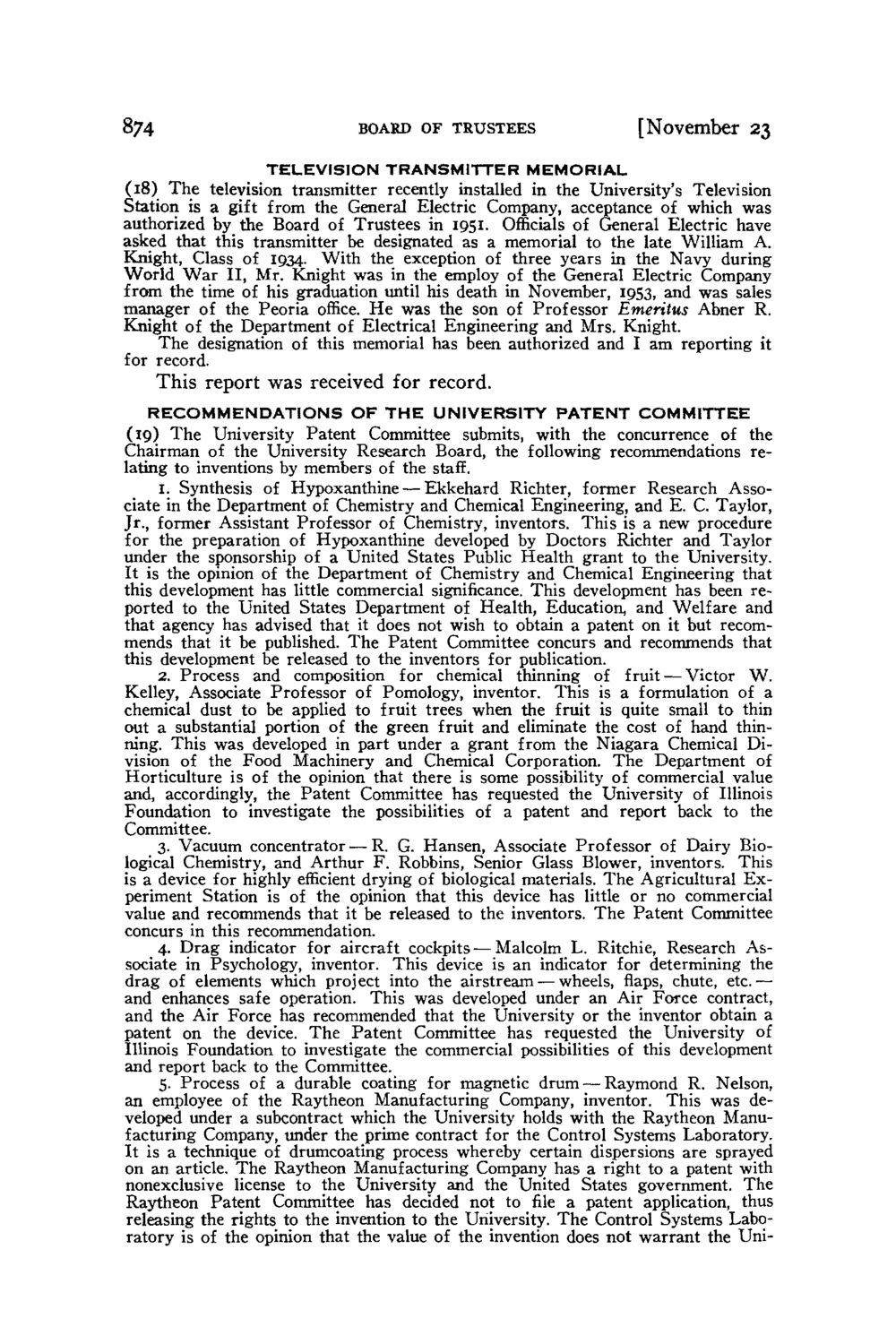| |
| |
Caption: Board of Trustees Minutes - 1956
This is a reduced-resolution page image for fast online browsing.

EXTRACTED TEXT FROM PAGE:
874 BOARD OF TRUSTEES [November 23 TELEVISION TRANSMITTER MEMORIAL (18) T h e television transmitter recently installed in the University's Television Station is a gift from the General Electric Company, acceptance of which was authorized by the Board of Trustees in 1951. Officials of General Electric have asked that this transmitter be designated as a memorial to the late William A. Knight, Class of 1934. With the exception of three years in the Navy during World W a r I I , Mr. Knight was in the employ of the General Electric Company from the time of his graduation until his death in November, 1953, and was sales manager of the Peoria office. H e was the son of Professor Emeritus Abner R. Knight of the Department of Electrical Engineering and Mrs. Knight. The designation of this memorial has been authorized and I am reporting it for record. This report was received for record. R E C O M M E N D A T I O N S O F T H E UNIVERSITY PATENT COMMITTEE (19) T h e University Patent Committee submits, with the concurrence of the Chairman of the University Research Board, the following recommendations relating to inventions by members of the staff. 1. Synthesis of Hypoxanthine — Ekkehard Richter, former Research Associate in the Department of Chemistry and Chemical Engineering, and E. C. Taylor, Jr., former Assistant Professor of Chemistry, inventors. This is a new procedure for the preparation of Hypoxanthine developed by Doctors Richter and Taylor under the sponsorship of a United States Public Health grant to the University. It is the opinion of the Department of Chemistry and Chemical Engineering that this development has little commercial significance. This development has been reported to the United States Department of Health, Education, and Welfare and that agency has advised that it does not wish to obtain a patent on it but recommends that it be published. T h e Patent Committee concurs and recommends that this development be released to the inventors for publication. 2. Process and composition for chemical thinning of fruit — Victor W . Kelley, Associate Professor of Pomology, inventor. This is a formulation of a chemical dust to be applied to fruit trees when the fruit is quite small to thin out a substantial portion of the green fruit and eliminate the cost of hand thinning. This was developed in part under a grant from the Niagara Chemical Division of the Food Machinery and Chemical Corporation. The Department of Horticulture is of the opinion that there is some possibility of commercial value and, accordingly, the Patent Committee has requested the University of Illinois Foundation to investigate the possibilities of a patent and report back to the Committee. 3. Vacuum concentrator — R. G. Hansen, Associate Professor of Dairy Biological Chemistry, and Arthur F . Robbins, Senior Glass Blower, inventors. This is a device for highly efficient drying of biological materials. The Agricultural E x periment Station is of the opinion that this device has little or no commercial value and recommends that it be released to the inventors. T h e Patent Committee concurs in this recommendation. 4. Drag indicator for aircraft cockpits—Malcolm L. Ritchie, Research Associate in Psychology, inventor. This device is an indicator for determining the drag of elements which project into the airstream — wheels, flaps, chute, etc.— and enhances safe operation. This was developed under an Air Force contract, and the Air Force has recommended that the University or the inventor obtain a patent on the device. T h e Patent Committee has requested the University of Illinois Foundation to investigate the commercial possibilities of this development and report back to the Committee. 5. Process of a durable coating for magnetic drum — Raymond R. Nelson, an employee of the Raytheon Manufacturing Company, inventor. This was developed under a subcontract which the University holds with the Raytheon Manufacturing Company, under the prime contract for the Control Systems Laboratory. It is a technique of drumcoating process whereby certain dispersions are sprayed on an article. The Raytheon Manufacturing Company has a right to a patent with nonexclusive license to the University and the United States government. The Raytheon Patent Committee has decided not to file a patent application, thus releasing the rights to the invention to the University. The Control Systems Laboratory is of the opinion that the value of the invention does not warrant the Uni-
| |